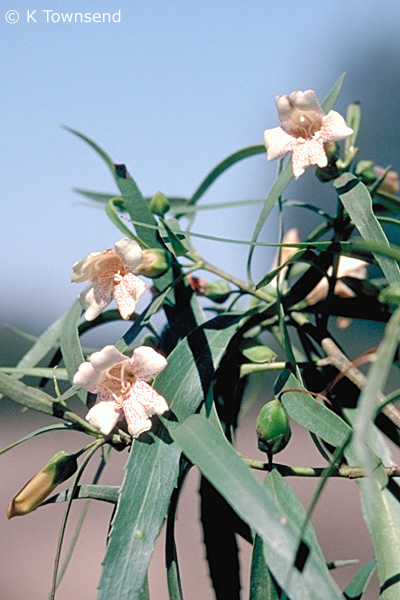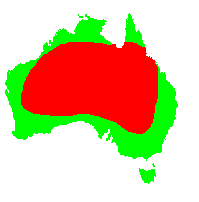General Description:
Eremophila is a large genus of 214 species, all endemic to Australia. They are generally plants of inland and arid areas and are popular with Australian plant enthusiasts.
Eremophila bignoniflora is medium to tall, dense, rounded shrub 3 to 5 metres tall. The older bark is dark grey, rough, fissured and somewhat tessellated and the foliage droops conspicuously. The leaves are alternate, narrow, 5-15cm long, tapered at both ends and pale green in colour. The young shoots are often sticky.
The cream flowers are up to 30mm long and bell-shaped with purplish streaks on the inner surface. They occur in winter and spring on long pedicels (flower stalks). The rounded, fleshy fruits are about 10-15mm in diameter.
E.bignoniflora grows well in dry climates on a variety of soils which must have good drainage. It has also been successfully cultivated in humid, temperate areas. The species will tolerate at least moderate frosts and prefers full sun.
The common name “Dogwood” is derived from the reputation that crushed leaves are said to smell similar to dog urine.
Propagation from seed of Eremophila species is unreliable. A number of treatment methods have been tried including sowing the ripe fruits, sowing of aged and washed fruits and splitting the fruits to extract the seeds prior to sowing. The latter involves splitting the fruits in halves and quarters but some seeds are inevitably damaged during the process.
E.bignoniflora strikes readily from cuttings of hardened, current season’s growth.

Eremophila bignoniflora
Photo: Keith Townsend
Images of all Eremophila species, hybrids and cultivars can be seen in the Eremophila Study Group’s Eremophila Image Database
 Australian Native Plants Society (Australia)
Australian Native Plants Society (Australia)